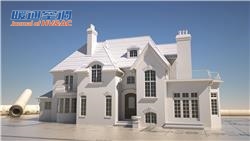热门
 Holmak: Heat exchanger made of PET
Holmak: Heat exchanger made of PET "China Water efficiency label management" implem…
"China Water efficiency label management" implem… Build Eco Xpo (BEX) Asia and Mostra Convegno Exp…
Build Eco Xpo (BEX) Asia and Mostra Convegno Exp… MOSTRA CONVEGNO EXPOCOMFORT (MCE) ASIA TO DEBUT…
MOSTRA CONVEGNO EXPOCOMFORT (MCE) ASIA TO DEBUT… CRAA published nameplate code of multi split air…
CRAA published nameplate code of multi split air… 2019 China AC market marked by slide domestic sa…
2019 China AC market marked by slide domestic sa… Global air conditioning systems market is expect…
Global air conditioning systems market is expect…
3D printing and buildings
by Chris Thompson, Research Engineer, BSRIA Sustainable Construction Group

When 3D printing is mentioned the first thing that will come to mind for most is a small square desktop sized printer that is more of a gimmick than a practical piece of equipment. This is mainly due to the explosion of home based 3D printers in the last few years which have drawn much attention to the additive manufacturing area. The idea of 3D printing seems interesting to most and at first the possibilities seem endless but it isn’t going to suddenly take over. Current manufacturing and assembly methods aren’t all going to be replaced and 3D printing most definitely has its limitations in terms of materials used and finished product characteristics.
3D printing isn’t a new technology; additive manufacturing (as it’s also known) has been around for many years. The main change has been improvements in technology around additive manufacturing. This allows for more materials to be used, increases the accuracy and resolution of the products made and other benefits which have increased the scope of what 3D printing can be used for.
So how is 3D printing useful in terms of the building services industry?
The most obvious use for 3D printing is in manufacturing and it has been readily taken up by many manufacturing firms using it for many tasks, one of the most common is prototyping. To be able to physically produce a part to test its capabilities, comparing with a similar design quickly and making alterations to the design. Also producing and testing it just as quick is an invaluable service that 3D printing can provide. This isn’t the limit of its use within manufacturing and within the BSRIA 3D Printing topic guide which has recently been released; more of these uses are discussed. Generally 3D printing won’t replace the mass production of parts as in most cases traditional methods are quicker and can produce parts with greater strength or other characteristics that a 3D printed component couldn’t replicate.
So outside of manufacturing products and parts for building services are there other uses?
Most people have heard of (maybe not completely understood) BIM; one aspect of BIM is using a 3D model to represent the building to be designed. This has many uses and aims to help different services collaborate in making the construction process from design through to completion and handover smoother and more efficient. The 3D model that is used to show the design is only a few steps away from being able to be converted and printed by a 3D printer. This allows a physical representation to be produced which may at first seem a bit redundant due to having a 3D computer model but is actually quite useful. A physical model can be shown to the client to explain features or how an area will work in terms of space. This also allows for the movement of objects in the model and to experiment with designs and positioning of equipment. A physical model can be a lot easier to use than working through a piece of software, where a software expert is needed to relay these ideas into the design. This allows for people to come around the design and easily spot problems and find solutions together, for example, showing how a busy area of riser will work whilst allowing access where necessary.
Looking beyond models
3D printing on grander scales has potential to improve construction possibilities as well as speed of construction. Currently the idea is still in development although many large structures have been created using 3D printing. Either creating areas of a building in a modular fashion, having them assembled on site or actually having a large framed 3D printing axis built on site and used to 3D print the walls of the building out of a concrete mixture. A lot of this is in the experimental phase but it could possibly replace many parts of the construction process, allowing the fabric and services to be intricately designed in ways which wouldn’t have previously been possible due to access needing to be required for installation. Currently many companies are trying to push the boundaries of what 3D printing can be used for with projects such as MX3D, who are trying to manufacture a steel bridge via 3D printing construction in Amsterdam. The most likely outcome for the near future is in modular construction, making parts of the building in factories and then transporting to and assembling on site.
There are a lot of possibilities for 3D printing in the future which may change many processes in building construction and the manufacture of products used in buildings, however we are definitely not there yet and many traditional methods are likely to be irreplaceable.
More information at https://www.bsria.co.uk




